IMS: What does it stand for? What could it stand for?
Peter Bühlmann gave the Presidential Address at the 2023 Joint Statistical Meetings in Toronto. The following text is based on his slides, which you can view here.
This is a picture of IMS: 
… and what follows is my own view and perspective (a.k.a. “picture”) of IMS.
What does IMS stand for? It stands for Institute of Mathematical Statistics. Perhaps this is an unusual name nowadays, but unusual can be good, distinguishing from the mainstream. Notice that it’s an “Institute” (as opposed to an association or society). Also, it’s “Mathematical Statistics”: there’s no explicit mention of probability, or of data science. More on these points later…
Let’s look at a bit of history, to see if we find some explanation. This draws from Stephen Stigler’s 1996 Statistical Science paper, “The History of Statistics in 1933,” and from the Wiley StatsRef article, “Institute of Mathematical Statistics (IMS),” written by Elyse Gustafson and Edsel Peña in 2019.
IMS was founded five years after the beginning of The Annals of Mathematical Statistics in 1930. The journal looked like this:

First issue of the Annals
Notice the American Statistical Association’s name across the top? The first article was written by Willford King, Secretary-Treasurer of the ASA (and later ASA President in 1935), entitled “Mathematical Statistics”—it’s two pages long, I recommend it! In it, he emphasized the importance of mathematical statistics as a promising new development: both for the “mathematically inclined members” and also for the less mathematical statisticians who would “recognize that the more advanced phases of mathematics are rendering extremely valuable service in furthering the progress of statistical technique, thus aiding in the solution of problems of the greatest moment” (King, 1930).
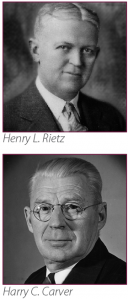
Henry Rietz and Harry Carver
However, things didn’t work out so well, and there were some issues around the division between these two “groups” (those devoted to advanced mathematics and those who were not). Growing disagreement then led to Harry C. Carver, the first editor of the Annals, taking it over in January 1934, at his own expense and maintaining it without institutional base. As Carver could not do this for too long, he came up with the idea of an association of mathematical statisticians. This triggered the official founding of the IMS. Thus, the Institute of Mathematical Statistics was founded on September 12, 1935, at Ann Arbor, Michigan, with Henry L. Rietz (University of Iowa) as its first President, Walter A. Shewhart as Vice-President, Allen T. Craig as Secretary-Treasurer, and Harry Carver as the main initiator and editor of its journal.
The founders chose the word “Institute.” Merriam Webster defines “institute” as “an organization for the promotion of a cause (motive)” and “association” as “an organization of persons having a common interest.” So, “institute” is not such a bad name!
At its inception, then, I would say that the new Institute of Mathematical Statistics stood for the promotion of—quoting again from the first article of the Annals of Mathematical Statistics—“…the more advanced phases of mathematics [which are] furthering the progress of statistical technique, thus aiding in the solution of the greatest moment” (King, 1930).
IMS: What does it stand for today?
Today, in 2023, you’ll find this on the IMS website banner: “Fostering the development and dissemination of the theory and applications of statistics and probability.”
If we want to find out about someone, we could read their CV. What might the CV of the IMS look like?

I’ll focus for now on “Recognition”. In short, I would say:
Relative to IMS’s size, with 4,670 members (2022), we do a lot!
Let me elaborate on this. First, look at our publications—Annals of Statistics, Annals of Probability, Annals of Applied Statistics, Annals of Applied Probability, Statistical Science, IMS Monographs and Textbooks, IMS Bulletin—and our co-sponsored publications—ACM/IMS Journal of Data Science, Electronic Communications in Probability, Electronic Journal of Probability, Electronic Journal of Statistics, Journal of Computational and Graphical Statistics, Probability Surveys, Statistics Surveys… IMS is highly recognized for its publications, which are among the best in the field!
What about our meetings and conferences? We hold them all over the world: we have a truly global reach! For example, the annual standalone meeting we hold every four years has most recently been in London, Vilnius, Sydney, Gothenburg, Rio de Janeiro, Banff; the Asia Pacific-Rim Meeting has been in Melbourne, Singapore, Hong Kong, Taipei, Tokyo, Seoul; the World Congress (with the Bernoulli Society) was held in Toronto, Istanbul, Singapore, Barcelona, Guanajuato, Vienna, Chapel Hill, Uppsala, Tashkent… and there have been many, many other meetings.
Let’s look at our awards and honors, again, we have many. There are the Awards & Named Lectures—honoring the contributions of Abraham Wald, David Blackwell, Lucien Le Cam, Jerzy Neyman, Henry Rietz, Grace Wahba, and, jointly with Bernoulli Society, Oded Schramm and Joseph Doob—and the Medallion lectures. We elect IMS Fellows. We award the Harry C. Carver Medal; the Peter Gavin Hall IMS Early Career Prize; the Tweedie New Researcher Award; and the IMS Lawrence D. Brown PhD Student Award. Our travel awards are for New Researchers and Graduate Students (Hannan Travel Award). Together, this makes a portfolio of awards from early*– to mid- and senior-career. Again, relative to IMS’s size of 4,670 members, we have very many awards!
*As you can see in the previous paragraph, early is asterisked. Early-career researchers are of the utmost importance! We created the IMS New Researchers Group, who are an independent sub-unit with a similar governance structure to IMS (the NRG president is Pragya Sur; they have just held the annual New Researchers Conference, in Toronto immediately before JSM, which was very successful.) It is IMS’s core responsibility to support the careers and research of the next generation, for at least two reasons: because we owe it to the next generation, and because only the next generation will keep up with new developments at sufficient speed.
There has been expansion in various directions over the years. For applied and interdisciplinary statistics, we have the Annals of Applied Statistics (started in 2007) which is by now a top journal; and, together with ACM, we have the brand-new ACM/IMS Journal of Data Science (inaugural issue available now) to strengthen the interaction with data science and machine learning. The International Congress of Statistics and Data Science, ICSDS, had its first highly successful meeting last December in Florence, and the next will be in Lisbon in December 2023. We have a new program, Industry Friends of IMS, founded in 2023 to stimulate intellectual exchange between industry and academia. [See Peter’s article here.]
And importantly, we have very many members who devote a huge amount of their time and passion to IMS endeavors. IMS can do all these things only with their volunteers. I think this is truly amazing! Thank you!
Where does IMS stand within the community? How do we compare? Let’s look at some membership data. Among national statistical societies, selecting two examples, the ASA has about 19,000 members; the Royal Statistical Society (RSS) about 10,000 members. In international statistical societies: the International Statistical Institute (ISI) ≈ 4,000 elected fellows; the International Biometric Society (IBS) ≈ 6,000 members (organized in 37 regions, and four networks); the International Society for Bayesian Analysis (ISBA) ≈ 900 members; the Bernoulli Society ≈ 760 members… and IMS, remember, has 4,670 members.
Where do we stand in “data science”? Looking at some Computer and Data Science (“regular”) societies: ACM (Association for Computing Machinery) has about 110,000 members from more than 190 countries; IEEE (Institute of Electrical and Electronics Engineers), which covers a lot of data science nowadays, has about 427,000 members from more than 190 countries, in 344 sections in ten geographic regions worldwide; INFORMS (Operations Research & Analytics) has ≈ 13,000 members from all continents. Machine learning societies have a somewhat different model, as they are built around major conferences as a society to run the conference. The International Machine Learning Society, for example, runs the annual ICML conference; the Neural Information Processing Systems Foundation runs the annual NeurIPS conference; the Association for Uncertainty in Artificial Intelligence runs the annual UAI conference.
So, IMS and other statistical societies are smaller and more homogeneous than the big CS/EE/data science “competitors”—yet are much broader in scope than just running an ML conference. I see this as a fantastic opportunity for IMS—and all other statistics societies!
IMS: What could it stand for?
We can always improve and develop great new projects, obviously. What could we do?
Let me just focus on this: What is the role of the “M” (“Mathematical”) in IMS? Mathematical Statistics was a “fashionable” new wave: about 100 years ago, it brought rigor and success to statistical analysis, and later, to data science and machine learning. What could the “M” stand for in the future?
Firstly, it could stand for foundational work in statistics and data science: by this, I mean general statistical and data science principles, new frameworks and paradigms (computational, methodological), mathematical theory and insights, and so on. There are a lot of exciting and new problems. Let’s find inspiration from interdisciplinary science, data science, machine learning, AI, industry problems. Among concrete interdisciplinary examples, it could be neuroscience, astrophysics, personalized medicine, climate science; and at the intersection with machine learning, I mention bias and fairness, data privacy, data integration and fusion, scalability and performance, interpretability and “explainability” (a.k.a. causality), adaptive and reinforcement learning, optimal transport in machine learning… And then there’s the nearly non-science-fiction future of quantum computing, a billion human genomes sequenced, human brain simulations and modeling 100 billion neurons… Let’s go out and actively participate in shaping the foundations of new data science problem domains; and importantly, also critically debate new developments. This is again a great opportunity!
Secondly, in modern probability—admittedly not my area of expertise—probability is nowadays a central field in mathematics. For example, the Fields Medal has been awarded to “pure” probabilists in 2006, 2014, and 2022. Could exposure to data science provide new developments in probability and mathematics? We definitely want to have probability on board in IMS!
Third, statistics remains connected to mathematics. I want to illustrate this point with two surprising stories where statisticians have recently proved major conjectures in mathematics.
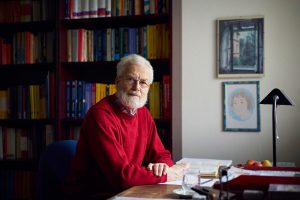
Thomas Royen
In 2014, the proof of the Gaussian Correlation Conjecture (now the Gaussian Correlation inequality): “As he was brushing his teeth on the morning of July 17, 2014, Thomas Royen, a little-known retired German statistician, suddenly lit upon the proof of a famous conjecture at the intersection of geometry, probability theory and statistics that had eluded top experts for decades.” (Quanta Magazine, 2017). Thomas Royen worked at Hoechst, a pharma company in Germany (1979–85) and then at the University of Applied Sciences in Bingen (1985–2010). And in 2020, the second time, the proof of the Kannan–Lovász–Simonovits (KLS) conjecture, as described in Quanta Magazine in 2021:

Yuansi Chen
“Statistics Postdoc Tames Decades-Old Geometry Problem. To the surprise of experts in the field, a postdoctoral statistician has solved one of the most important problems in high-dimensional convex geometry.” This was Yuansi Chen, a former PhD student of Bin Yu, currently at Duke University.
Why were Thomas Royen and Yuansi Chen interested in doing pure mathematics? Did they see a connection to their statistical work? It does open new paths! For example, the KLS conjecture has fundamental consequences for MCMC and stochastic optimization in statistical modeling and data science.
We may have different ways to interpret the “M” and thus we may also say the “M” stands for “Multi-faceted”—like this mirror.

A multi-faceted mirror. Image from https://www.commutedesign.com/large-scale/multi-faceted-mirror
Multi-faceted in terms of areas, fields, approaches, methods, algorithms, mathematical theories, applications—and in terms of people with diverse backgrounds and strengths.
What could IMS stand for? IMS is growing more multi-faceted. We must take a broad view to develop this further. Theory is not better than applications; applications are not more relevant or impactful than theory; and so on.
There are different facets of people, specifically of IMS members, in terms of gender, personal background, scientific culture, scientific expertise, age group, geographical location and origin, etc.
What are the assets and challenges for a Multi-faceted IMS? As a first asset, we are exceptionally well positioned to build further on our global reach. The IMS membership surveys in 2013 and 2021 showed a significant growth in members from Asia—and according to the 2022 membership directory, the regional presence of members is: Africa 3%, Asia 23%, Europe 22%, North America 48%, Oceania 2%, South America 2%.
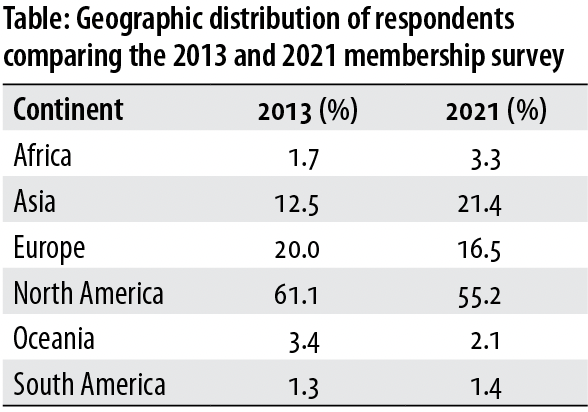
Table showing geographic distribution of respondents comparing the 2013 and 2021 membership survey
And, as I mentioned before, we have conferences all over the world. Multi-faceted should truly be global in 2023 and beyond. Can we give to and receive from all six continents? I very much hope so!
Another significant asset is our long tradition and great expertise in mathematical foundations. You may recall Bin Yu’s IMS Presidential Address in 2014, “Let Us Own** Data Science” (** “Own” here does not exclude other owners of data science.) This has been a great message for almost 10 years, but we must realize that owning data science is a too big endeavor for the statistics community alone. Thus, I’d rather say,
“Let Us Shape*** the Foundations of Data Science”
(*** “Shape” here does not exclude others!).
We are in an excellent position to do this—but we need to add this facet to our thinking and to the IMS core portfolio of activities, such as the aforementioned ICSDS meetings, the ACM/IMS Journal of Data Science, and so on.
Here’s one challenge: demographics. From the IMS membership survey 2021, we see:
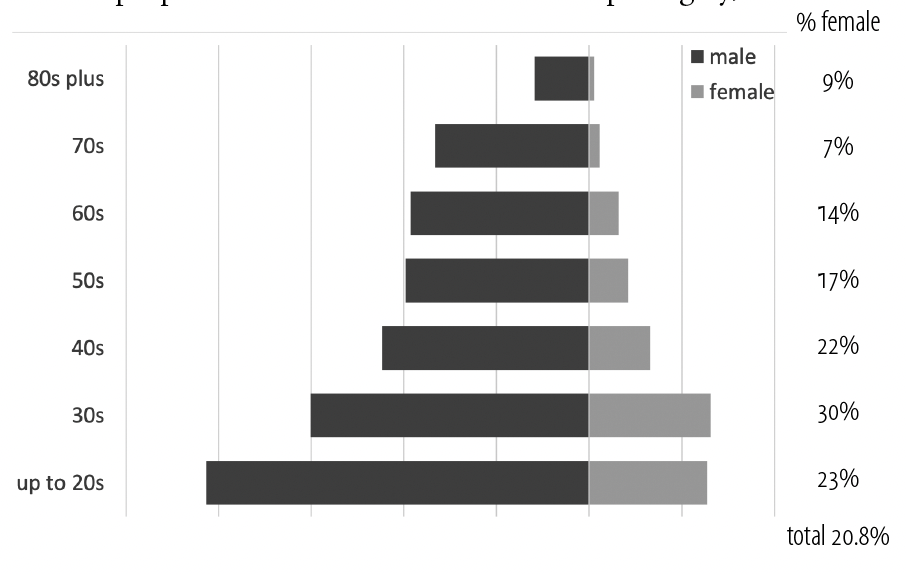
Graph showing proportions of male and female members in different age categories
The proportion of women is indicated in paler gray, the different age brackets (30s means 30–39 years old) are on the left and the corresponding percentages on the right. It is clear that in 2023 and beyond, we must have more women in IMS. Does a multi-faceted culture help to achieve this goal? I very much think so!
Will you participate in making the IMS more multi-faceted? Come with us on the journey to shape IMS’s future.
IMS:
truly International,
truly Multi-faceted,
truly Statistics-and-Probability!
I count on your participation!
Behind the curtain of IMS: Some words of thanks
In closing, I would like to share my appreciation of a few people.
Firstly, our Executive Director Elyse Gustafson, who is incredibly experienced, efficient, encouraging, kind and supportive—and she likes working with everybody!
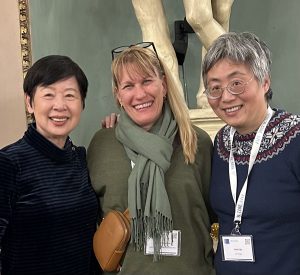
Left-right: Regina Liu, Elyse Gustafson, Annie Qu, pictured at the inaugural ICSDS meeting in Florence in 2022
Pictured here with Regina Liu and Annie Qu, who initiated the International Congress of Statistics and Data Science (ICSDS).
The IMS Bulletin editor Tati Howell is extremely skilled in communication on all levels, helpful, supportive, and very kind.
Edsel Peña, who is very knowledgeable about IMS, always available, reliable, exacting about the details, and very kind! Edsel is finishing his six-year (double) term as IMS Executive Secretary. Thank you for your long commitment and dedication to IMS.
Former President Chris Burdzy, who is very knowledgeable and highly responsible about IMS, thinks logically, is meticulous about the details and gives constructive and honest advice. Thank you for all your time and dedication for IMS as President-Elect, President and Past President!
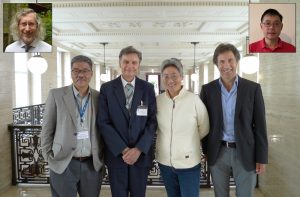
The 2022–23 IMS Executive Committee: [inset left] President-Elect Michael Kosorok, [standing, left to right] Executive Secretary Edsel Peña, Past-President Krzysztof (Chris) Burdzy, Program Secretary Annie Qu, President Peter Bühlmann, and [inset right] IMS Treasurer Jiashun Jin
Michael Kosorok (President-Elect), Annie Qu (Program Secretary), Jiashun Jin (Treasurer) as additional members of a very constructive Executive Committee.
Our team members over very many years: Patrick Kelly (IMS Production Editor), Laila Lunderman (Webmaster), Geri and Krissi Mattson (of Mattson Publishing Services), Larissa Puryear (Dues and Subscriptions, LP Society Services)
…and, last but not least: you, the 4,670 members! Including a huge number of reviewers, associate and co-editors, committee members for many tasks (meetings, awards, outreach, DEI, …)
As IMS President I could see the true reality behind the curtain: that IMS crucially depends on the work from all these very many volunteers. I am deeply impressed and grateful for all the excellent work you do for IMS. Thank you!